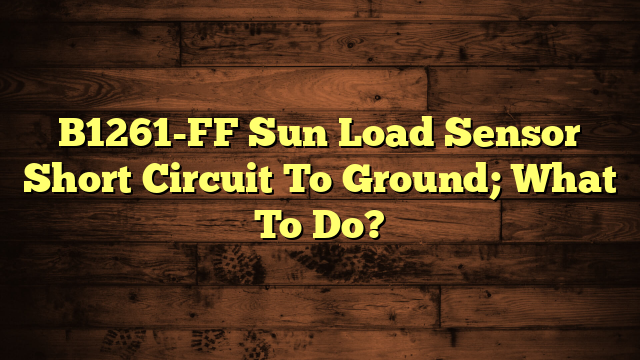“Under the Hood: Demystifying Cummins MAP Sensors for Peak Performance!” – 2023
Introduction
Cummins engines are renowned for their durability, power, and reliability, powering a wide range of vehicles and machinery. One of the crucial components that contribute to their exceptional performance is the Manifold Absolute Pressure (MAP) sensor. This unsung hero plays a pivotal role in optimizing fuel injection and ensuring efficient engine operation.
What is a Cummins MAP Sensor?
In essence, a Cummins MAP sensor is a pressure transducer that monitors the air pressure in the intake manifold. This pressure reading is a critical indicator of engine load and air density, which directly influences fuel injection timing and quantity. By accurately gauging intake manifold pressure, the MAP sensor provides invaluable data to the Engine Control Unit (ECU), enabling it to fine-tune fuel delivery for optimal combustion.

The Significance of Cummins MAP Sensors
Cummins MAP sensors are instrumental in maintaining optimal engine performance and efficiency. They play a crucial role in achieving the following:
- Precise Fuel Injection: Accurate MAP sensor readings ensure that the correct amount of fuel is injected into the engine cylinders, optimizing combustion and preventing fuel wastage.
- Efficient Engine Operation: MAP sensors contribute to smooth and efficient engine operation by providing real-time data to the ECU, allowing it to make adjustments to fuel injection timing and air-fuel mixture based on varying engine loads and conditions.
- Power and Fuel Economy: By ensuring optimal fuel injection and combustion, MAP sensors contribute to maximizing engine power output while maintaining fuel economy.
Troubleshooting Cummins MAP Sensor Issues
A malfunctioning Cummins MAP sensor can lead to a range of engine performance issues, including:
- Reduced Power and Fuel Economy: Inaccurate MAP sensor readings can cause the engine to run lean or rich, resulting in reduced power and compromised fuel economy.
- Rough Idle and Stalling: Faulty MAP sensor signals can lead to rough idle, stalling, and hesitation during acceleration.
- Illuminated Check Engine Light: A malfunctioning MAP sensor may trigger the Check Engine Light (CEL), indicating an Engine Control Module (ECM) fault code.
Replacing a Cummins MAP Sensor
Replacing a Cummins MAP sensor is a relatively straightforward procedure that can be performed by a DIY enthusiast with basic mechanical skills and tools. The process typically involves the following steps:
- Locating the MAP Sensor: The MAP sensor is typically located on the intake manifold or intake plenum, depending on the engine model.
- Disconnecting the Electrical Connector: Carefully detach the electrical connector from the MAP sensor.
- Removing the MAP Sensor: Use a Torx wrench to remove the bolt or screws securing the MAP sensor to its mounting bracket.
- Installing the New MAP Sensor: Gently insert the new MAP sensor into the mounting bracket and secure it with the appropriate bolt or screws.
- Reconnecting the Electrical Connector: Firmly reconnect the electrical connector to the MAP sensor.
- Clearing Error Codes: If a Check Engine Light is illuminated, connect a diagnostic scanner to clear any stored error codes.

Preventing Cummins MAP Sensor Issues
To prolong the life of your Cummins MAP sensor and minimize the risk of malfunction, consider the following preventive measures:
- Regular Air Filter Maintenance: Regularly replace the air filter to ensure clean air intake and prevent contamination of the MAP sensor.
- Inspection for Leaks: Periodically inspect the intake system for leaks that could affect intake manifold pressure readings.
- Careful Handling: Avoid excessive handling or jarring of the MAP sensor during maintenance procedures.
By understanding the role of Cummins MAP sensors, recognizing the signs of malfunction, and implementing preventive measures, you can maintain optimal engine performance, fuel economy, and longevity.
Understanding the Basics
Origins and Evolution
Tracing the Roots
The concept of measuring manifold absolute pressure (MAP) dates back to the early days of internal combustion engines. Engineers recognized the need to monitor air intake pressure to optimize fuel injection and engine performance. Early MAP sensors, however, were rudimentary devices that relied on mechanical principles and provided limited accuracy.
Evolutionary Milestones
The invention of electronic MAP sensors in the 1960s revolutionized control systems for engines. These sensors offer greater accuracy, reliability and sensitivity. This allowed for better fuel injection and increased engine performance. Contemporary Cummins MAP sensors are extremely sophisticated devices that use the most advanced semiconductor technology to deliver the most accurate, real-time data for the Engine Control Unit (ECU).
Demystifying the Terminology
Decoding MAP: Not Just Cartography
While the term “MAP” might conjure up images of maps and navigation, in the context of engines, it stands for Manifold Absolute Pressure. This term refers to the air pressure measured within the intake manifold, a chamber that collects air from the intake system before it enters the engine cylinders.
Sensor Insights: Beyond the Surface
MAP sensors are not just simple pressure gauges; they are sophisticated transducers that convert physical pressure into electrical signals. These signals are then interpreted by the ECU, which uses them to calculate air density, a crucial parameter for fuel injection calculations. Modern MAP sensors often incorporate additional sensors, such as temperature sensors, to provide even more comprehensive data to the ECU.
The Intricate Mechanism – Cummins MAP Sensors
Inner Workings Unveiled
Behind the seemingly simple facade of a MAP sensor lies a complex interplay of electronic components and physical principles. Let’s delve into the intricate workings of these devices to understand how they transform pressure into meaningful information for the Engine Control Unit (ECU).
Sensor Anatomy 101
At the heart of a MAP sensor lies a pressure-sensitive diaphragm. The thin elastic material is designed to deflect in various air pressures, just as a balloon that is expanding and deflating. The diaphragm’s motion is transformed to electrical signal by the strain gauge instrument that changes mechanical strain (in this instance diaphragm deflection) into electrical resistance.
The Dance of Electrons
The strain gauge, typically composed of a thin film of resistive material, undergoes a change in resistance as the diaphragm deflects. This change in resistance, proportional to the applied pressure, alters the flow of current through the strain gauge. This variation in current forms the basis of the electrical signal sent to the ECU.
Unraveling the Technology – Cummins MAP Sensors
Two primary technologies are employed in MAP sensors: analog and digital. Analog MAP sensors produce a continuous voltage signal that varies directly with the applied pressure. Digital MAP sensors, on the other hand, convert the pressure signal into a digital format using an internal analog-to-digital converter (ADC).
Beyond the Binary: Analog vs. Digital
Analog MAP sensors offer the advantage of simplicity and lower cost. However, they are susceptible to noise and interference, potentially affecting the accuracy of the pressure readings. Digital MAP sensors, while more expensive, provide superior accuracy and immunity to noise, making them the preferred choice in modern engine control systems.
Sensing the Pressure: A Technical Deep Dive
The sensing element in a MAP sensor, whether analog or digital, is typically a piezoresistive sensor. This type of sensor relies on the property of certain materials, such as silicon, to exhibit a change in electrical resistance when subjected to mechanical stress. The diaphragm’s deflection induces stress in the piezoresistive material, causing a proportional change in its resistance.
Accurate pressure measurement in a MAP sensor requires compensation for temperature variations, as the electrical properties of the sensing element are sensitive to temperature changes. Temperature compensation techniques, such as incorporating a temperature sensor or using special temperature-stable materials, ensure reliable pressure readings across a wide range of operating temperatures.
The output signal from the MAP sensor is then amplified and filtered to remove noise and interference before being sent to the ECU. The ECU, equipped with calibration parameters specific to the engine, interprets the MAP sensor signal to determine air density and adjust fuel injection accordingly.
Applications Across Industries
MAP sensors have transcended the confines of automotive engines and found applications in a diverse range of industries, each with unique challenges and opportunities for innovation.
Automotive Marvel: Powering Vehicles
In the automotive realm, MAP sensors play a pivotal role in optimizing engine performance, fuel economy, and emissions control. They provide real-time data on engine load and air density, enabling precise fuel injection and ignition timing adjustments. This translates into improved power delivery, reduced fuel consumption, and lower emissions.
Conclusion – Cummins MAP Sensors
MAP sensors have emerged as indispensable components in a wide range of applications, from powering vehicles to optimizing industrial processes. Their ability to accurately measure and translate pressure into meaningful information has revolutionized engine control systems, enhanced industrial automation, and contributed to environmental sustainability.
As technology advances, MAP sensors will continue to evolve, incorporating new materials, advanced sensing techniques, and intelligent communication capabilities. These advancements will further enhance their precision, reliability, and versatility, making them even more integral to the future of various industries.
FAQs
What is the difference between an analog and a digital MAP sensor?
Analog MAP sensors produce a continuous voltage signal that varies directly with the applied pressure, while digital MAP sensors convert the pressure signal into a digital format using an internal analog-to-digital converter (ADC). Digital MAP sensors offer superior accuracy and immunity to noise compared to analog sensors.
How does a temperature sensor compensate for temperature variations in a MAP sensor?
Temperature compensation techniques are employed to counteract the sensitivity of the MAP sensor’s sensing element to temperature changes. One common method involves incorporating a temperature sensor into the MAP sensor, which provides feedback to the ECU. The ECU then uses this temperature data to adjust the MAP sensor signal, ensuring accurate pressure readings across a wide range of operating temperatures.
What are some of the challenges faced in designing MAP sensors for industrial applications?
Industrial MAP sensors must withstand harsh environmental conditions, including extreme temperatures, vibrations, and exposure to chemicals or solvents. They must also maintain high accuracy and reliability over extended periods of operation. To address these challenges, industrial MAP sensors are often designed with rugged materials, robust packaging, and advanced signal processing techniques.
What are some of the applications of MAP sensors beyond automotive and industrial settings?
MAP sensors are also employed in a variety of other fields, including:
- Medical devices for monitoring respiratory parameters
- Environmental monitoring systems for tracking air pressure and quality
- Aerospace applications for measuring air pressure and density in flight
- Consumer electronics for pressure sensing in appliances and wearable devices
The versatility and adaptability of MAP sensors have made them indispensable across industries, and their continued development promises to expand their applications even further.






